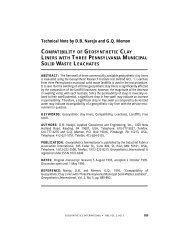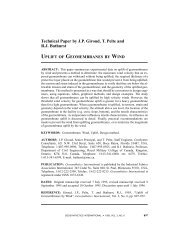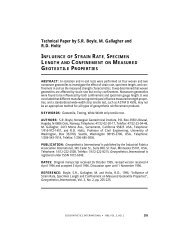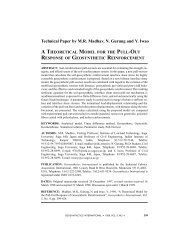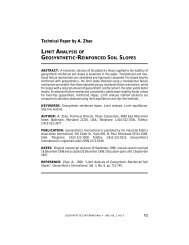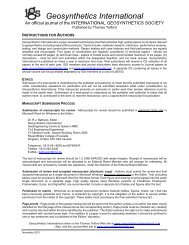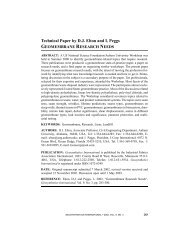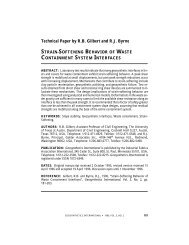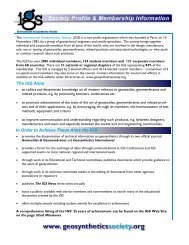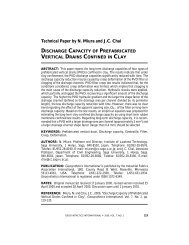Technical Paper by JP Giroud, KL Soderman and K. Badu-Tweneboah
Technical Paper by JP Giroud, KL Soderman and K. Badu-Tweneboah
Technical Paper by JP Giroud, KL Soderman and K. Badu-Tweneboah
Create successful ePaper yourself
Turn your PDF publications into a flip-book with our unique Google optimized e-Paper software.
GIROUD et al. D Optimal Configuration of a Double Liner System<br />
is a composite liner (Column B, Figure 2b). Each of the four pairs of cells (1A - 1B, 2A<br />
- 2B, 3A - 3B, <strong>and</strong> 4A - 4B) corresponds to one of the four cases defined in Section 3.1.<br />
The first of these four pairs of cells is related to the case presented in detail in Section<br />
3.2. Each of these eight cells comprises four lines: one line for the result of each of the<br />
four steps defined in Section 2.1.<br />
Comparing Columns A <strong>and</strong> B in Table 1, it appears that calculated values of the rate<br />
of leachate migration into the ground (i.e. the rate of leachate migration through the<br />
secondary liner, q 2 ) are smaller when the primary liner is a composite liner <strong>and</strong> the secondary<br />
liner is a geomembrane liner than with the inverse configuration.<br />
4 DISCUSSION AND CONCLUSIONS<br />
4.1 Discussion of the Results<br />
4.1.1 Liner System Configuration<br />
The purpose of this paper was to compare two configurations of double liner systems:<br />
(i) a double liner system where the primary liner is a geomembrane <strong>and</strong> the secondary<br />
liner is a composite liner; <strong>and</strong> (ii) a double liner system where the primary liner is a composite<br />
liner <strong>and</strong> the secondary liner is a geomembrane. In the double liner systems used<br />
for the comparison, the composite liner consists of a geomembrane on a GCL (Figure<br />
2). The comparison was performed <strong>by</strong> calculating the rate of leachate migration due to<br />
geomembrane defects. The results of the calculations, presented in Table 1, show that<br />
the rate of leachate migration into the ground is significantly less with the second configuration<br />
(Figure 2b) than with the first (Figure 2a). Therefore, if a design engineer has<br />
to choose between the two double liner systems described above, it may be recommended,<br />
on the basis of the comparison presented in this paper, to use the composite<br />
liner as the primary liner <strong>and</strong> the geomembrane liner as the secondary liner. However,<br />
this recommendation is mostly applicable to the case where the composite liner consists<br />
of a geomembrane on a GCL. If the composite primary liner consists of a geomembrane<br />
on a layer of compacted clay, compaction of the clay component of a primary liner may<br />
damage the underlying geosynthetics, i.e. the geonet secondary leachate collection system<br />
<strong>and</strong> the geomembrane secondary liner, which would likely cause more leachate<br />
migration through the secondary liner.<br />
It should be remembered that, as mentioned in Section 1, the comparison presented<br />
in this paper is based on advective flow calculations. A different ranking of the liner<br />
systems might have been obtained if other migration mechanisms (such as diffusion)<br />
had been considered.<br />
4.1.2 Magnitude of Leachate Migration Rate<br />
The calculated rates of leachate migration into the ground (q 2 in Table 1) are extremely<br />
small. The largest value of q 2 calculated, 1.42 × 10 -17 m/s, is equivalent to 5 × 10 -3<br />
liters per hectare per year, which should cause virtually no pollution. However, it should<br />
be remembered that mechanisms of contaminant migration other than advective flow<br />
have not been considered in this study. Nevertheless, it is clear that double liner sys-<br />
386 GEOSYNTHETICS INTERNATIONAL S 1997, VOL. 4, NOS. 3-4



